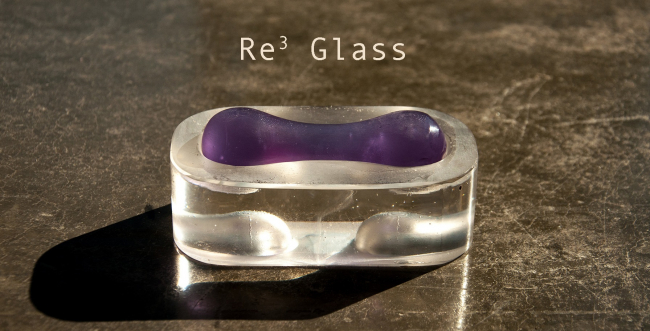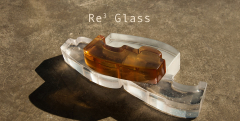New: solid 3-dimensional glass components Re3

05 februari 2018: The “Re3 Glass” project is the new generation of REcyclable, REducible and REusable cast glass components, which suggests an innovative and sustainable way of building with glass.
New: solid 3-dimensional glass components Re3
The applicability of glass in structures is continuously ascending, as the transparency and high compressive strength of the material render it the optimum choice for realizing diaphanous structural components that allow for light transmittance and space continuity. The fabrication boundaries of the material are constantly stretching: visible metal connections are minimized and glass surfaces are maximized, resulting to pure all-glass structures. Still, due to the prevalence of the float glass industry, all-glass structures are currently confined to the limited forms and shapes that can be generated by planar, 2D glass elements. Moreover, despite the fact that glass is fully recyclable, most of the glass currently employed in buildings is neither reused nor recycled due to its perplexed disassembly and its contamination from coatings and adhesives.
Cast glass can be the answer to the above restraints, as it can escape the design limitations generated from the 2-dimensional nature of float glass. By pouring molten glass into moulds, solid 3-dimensional glass components can be attained of considerably larger cross-sections and of virtually any shape. These monolithic glass objects can form repetitive units for large all glass-structures that do not buckle due to slender proportions and thus can take full advantage of the stated compressive strength of glass. Such components can be accordingly shaped to interlock towards easily assembled structures that do not require the use of adhesives for further bonding. In addition, cast glass units - due to their increased cross section - can tolerate a higher degree of impurities and thus can be produced by using waste glass as a raw source.
Grasping this potential, the Re3 Glass project aims to develop a methodology and guideline for the sustainable application of structural glass in buildings in respect to the waste hierarchy of Recycle, Reduce and Reuse. In specific, a threefold Re3 approach is suggested.
Step 1. REcycle by employing waste glass
Although in theory glass can be endlessly remelted without loss in quality, in practice only a small percentage gets recycled, mainly by the float and packaging industry. Most of the discarded glass fails to pass the high quality standards of the prevailing glass industry -due to coatings, adhesives, other contaminants or incompatibility of the recipe- and ends up in the landfill. However, employing discarded glass in cast components for building applications can be a way to reintroduce this waste to the supply chain. This is because such components can tolerate a higher percentage of inclusions, without necessarily compromising their mechanical or aesthetical properties.
Step 2. REduce by implementing smart geometry
The use of cast glass is proposed instead of the commonly applied laminated float glass, to achieve solid monomaterial components of the desired cross section and form. Owing to their large cross-sectional area and monolithic nature, cast glass components besides having an unlimited freedom in shapes, can form repetitive units for the generation of 3-dimensional, self-supporting glass facades and walls, sparing the necessity of an additional supporting structure. Smart geometry implemented in the form of cavities and notches leads to lightweight yet strong components, reducing not only the required raw material but also the overall embodied energy.
Step 3. REuse by designing interlocking components
Currently, the few realized structures using cast glass components employ either a steel substructure or an adhesive of high bonding strength, typically less than 2mm thick, to ensure the rigidity and lateral stability of the construction. Whereas the first solution compromises the overall level of transparency, the second results to a permanent construction of intensive and meticulous labour and extreme accuracy requirements. In this research the potential of a novel, reversible glass system comprising dry-assembly, interlocking cast glass components is explored. Owing to its interlocking geometry, the proposed system can attain the desired stiffness and stability with the aid of minimal metal framing. Furthermore, the suggested system circumvents the use of adhesives by using a dry, colourless interlayer as an intermediate between the glass units. Besides preventing stress concentrations due to glass to glass contact, the dry interlayer can also accommodate the inevitable dimensional tolerances in the cast units’ size. Most important, the dry-assembly design allows for the circular use of the glass components, as they can be eventually retrieved intact and reused.
Proof of concept
To validate the concept, different component geometries are developed and assessed in terms of mechanical interlocking capacity, mass distribution and ease of fabrication. Numerical models are made to predict the most sensitive areas in the brick designs. In parallel, research is conducted on different materials and production methods for the dry, transparent interlayer. As a proof of concept, the most promising interlocking forms are kilncast in 1:2 scale. The components are then dry-assembled in series of three and structurally tested under shear, to demonstrate the feasibility of the system.
Simultaneously, the potential but also the limitations of recycling glass in order to obtain load-bearing components are assessed. In this direction, an overview is provided regarding the types of glass that reach the recycling plants and the types that do not, arguing on the reasons behind this selection. A series of experiments questions the possibility of recycling everyday glass waste, from beer bottles and Pyrex® trays to mobile phone screens. Each type of glass waste is initially cast separately to define the flow capability at a temperature range between 900-1100°C, the risk of crystallisation, and the alterations in colour due to oxidation and reduction. Flux agents are added to samples of high viscosity at the aforementioned temperature range to facilitate the flow and reduce the required energy for recycling. Then, the possibility to mix different glass recipes at temperatures between 900-1450°C without cracking during the cooling and annealing cycle is evaluated. Aim of this research step is to achieve homogeneity in the glass components and good physical and mechanical properties despite the initial incompatibility of the mixed glass types.
filmpje Solid 3-dimensional glass components Re3 (0:06)
Credits
TU Delft Faculty of Civil Engineering and Geosciences, Faculty of Architecture and the Built Environment:
ir Telesilla Bristogianni; ir Faidra Oikonomopoulou; ir Lida Barou; dr ir Fred Veer; Prof.ir Rob Nijsse
TU Delft MSc students: ir Erwin Jacobs and Giulia Frigo.
University of Twente Faculty of Engineering Technology:
dr ir Elma Durmisevic and ir Pieter Beurskens.
Southern Illinois University (SIU), School of Art and Design:
Prof. Jiyong Lee and Katherine Rutecki.
pics: Faidra Oikonomopoulou - TU Delft Christal Houses Researchteam

